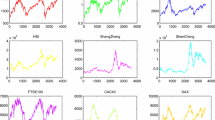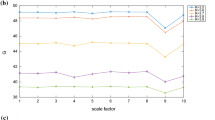Abstract
This study proposes a modified recurrence quantification analysis, called global recurrence quantification analysis (GRQA). It is well known that the recurrence threshold is an important parameter in traditional recurrence quantification analysis. However, in existing researches, the selection of recurrence thresholds is often based on ‘rules of thumb.’ As many studies have shown, recurrence analysis and its quantifiers are strongly dependent on the evaluation of the vicinity threshold parameter, which indicates that a selected threshold may have an adverse effect on exploring signal inherent information and the interrelationship between different sequences. Therefore, GRQA is initialized in this paper to measure the vertical and diagonal structures of recurrence plots in a more objective way, because it considers all the information carried by all potential values of the threshold. The information described by GRQA is determined by the sequence itself and is not affected by specific thresholds. GQRA can also clearly depict the dynamical similar characteristics and recursive trajectories between sequences, which have not appeared in previous researches. We apply this method to the financial time series to find some useful information. It reveals that SZSE and SSE show similar inherent dynamic characteristics via GQRA statistics curves, and DJI and NASDAQ are similar to each other as well, while HSI is like a combination of these two groups with both of their characteristics, which is consistent with its financial background.
































































Similar content being viewed by others
Notes
It means if we let \(\sigma \) as a unit of ‘gap,’ N plays an important role to ensure all the data in \(\mathrm{vec}\_R^{m,\tau }\) can be covered in \(N*\sigma \) gaps.
References
Eckmann, J.P., Kamphorst, S.O., Ruelle, D.: Recurrence plots of dynamical systems. Europhys. Lett. 4(9), 973–977 (1987)
Webber, J.C., Zbilut, J.P.: Dynamical assessment of physiological systems and states using recurrence plot strategies. J. Appl. Physiol. 76(2), 965 (1994)
Zbilut, J.P., Webber, L.C.: Embeddings and delays as derived from quantification of recurrence plots. Phys. Lett. A 171, 199–203 (1992)
Marwan, N., Wessel, N., Meyerfeldt, U., Schirdewan, A., Kurths, J.: Recurrence plot based measures of complexity and their application to heart-rate-variability data. Phys. Rev. E 66(2), 026702 (2002)
Naschitz, J.E., Sabo, E., Naschitz, S., Rosner, I., Rozenbaum, M., Priselac, R.M., Gaitini, L., Zukerman, E., Yeshurun, D.: Fractal analysis and recurrence quantification analysis of heart rate and pulse transit time for diagnosing chronic fatigue syndrome. Clin. Auton. Res. 12(4), 264–272 (2002)
Naschitz, J.E., Itzhak, R., Shaviv, N., Khorshidi, I., Sundick, S., Isseroff, H., Fields, M., Priselac, R.M., Yeshurun, D., Sabo, E.: Assessment of cardiovascular reactivity by fractal and recurrence quantification analysis of heart rate and pulse transit time. J. Hum. Hypertens. 17(2), 111–118 (2003)
Acharya, U.R., Sree, S.V., Chattopadhyay, S., Yu, W., Ang, P.C.A.: Application of recurrence quantification analysis for the automated identification of epileptic eeg signals. Int. J. Neural Syst. 21(03), 199–211 (2011)
Bastos, J.A., Caiado, J.: Recurrence quantification analysis of global stock markets. Phys. A 390(7), 1315–1325 (2012)
Bastos, J.A.: Recurrence quantification analysis of financial markets. Chaos Complex. Theory Manag. Nonlinear Dyn. 57(6), 857–62 (2013)
Guhathakurta, K., Bhattacharya, B., Chowdhury, A.R.: Using recurrence plot analysis to distinguish between endogenous and exogenous stock market crashes. Phys. A 389(9), 1874–1882 (2010)
Nichols, J.M., Trickey, S.T., Seaver, M.: Damage detection using multivariate recurrence quantification analysis. Mech. Syst. Signal Process. 20(2), 421–437 (2006)
Zbilut, J.P., Giuliani, A., Webber, C.L., Colosimo, A.: Recurrence quantification analysis in structure-function relationships of proteins: an overview of a general methodology applied to the case of tem-1 beta-lactamase. Protein Eng. 11(2), 87 (1998)
Roma, G., Nogueira, W., Herrera, P.: Recurrence quantification analysis features for environmental sound recognition. BMC Public Health 9(1), 1–9 (2013)
Fabretti, A., Ausloos, M.: Recurrence plot and recurrence quantification analysis techniques for detecting a critical regime. Int. J. Mod. Phys. C 16(05), 671–706 (2011)
Mosdorf, R., Dzienis, P., Litak, G.: The loss of synchronization between air pressure fluctuations and liquid flow inside the nozzle during the chaotic bubble departures. Meccanica 52(11–12), 2641–2654 (2017)
Ren, W., Jin, N.: Vector visibility graph from multivariate time series: a new method for characterizing nonlinear dynamic behavior in two-phase flow. Nonlinear Dyn. 97(4), 2547–2556 (2019)
Rusinek, R., Zaleski, K.: Dynamics of thin-walled element milling expressed by recurrence analysis. Meccanica 51(6), 1275–1286 (2016)
Knight, A.P., Kennedy, D.M., McComb, S.A.: Using recurrence analysis to examine group dynamics. Group Dyn. Theory Res. Pract. 20(3), 223 (2016)
Bianchi, F.M., Livi, L., Alippi, C.: Investigating echo-state networks dynamics by means of recurrence analysis. IEEE Trans. Neural Netw. Learn. Syst. 29(2), 427–439 (2016)
Piu, P., Serchi, V., Rosini, F., Rufa, A.: A cross-recurrence analysis of the pupil size fluctuations in steady scotopic conditions. Front. Neurosci. 13, 407 (2019)
Sarkar, S., Dey, A.: Classifying recurrent dynamics on emotional speech signals. In: Intelligent Speech Signal Processing, pp. 139–152 (2019)
Stender, M., Oberst, S., Tiedemann, M., Hoffmann, N.: Complex machine dynamics: systematic recurrence quantification analysis of disk brake vibration data. Nonlinear Dyn. 97(4), 2483–2497 (2019)
Eroglu, D., Peron, T.K., Marwan, N., Rodrigues, F.A., Costa, L.D., Sebek, M., Kiss, I.Z., Kurths, J.: Entropy of weighted recurrence plots. Phys. Rev. E 90(4), 042919–042919 (2014)
Ding, H.: Characterization of local complex structures in a recurrence plot to improve nonlinear dynamic discriminant analysis. Phys. Rev. E 89(1), 013313 (2014)
Chen, Y., Yang, H.: Multiscale recurrence analysis of long-term nonlinear and nonstationary time series. Chaos Solitons Fractals 45(7), 978–987 (2012)
Xiang, R., Zhang, J., Xu, X.K., Small, M.: Multiscale characterization of recurrence-based phase space networks constructed from time series. Chaos 22(1), 47 (2012)
Kraemer, K.H., Donner, R.V., Heitzig, J., Marwan, N.: Recurrence threshold selection for obtaining robust recurrence characteristics in different embedding dimensions. Chaos 28(8), 085720 (2018)
Prado, TdL, dos Santos Lima, G.Z., Lobão-Soares, B., do Nascimento, G.C., Corso, G., Fontenele-Araujo, J., Kurths, J., Lopes, S.R.: Optimizing the detection of nonstationary signals by using recurrence analysis. Chaos 28(8), 085703 (2018)
Mindlin, G.B., Gilmore, R.: Topological analysis and synthesis of chaotic time series. Phys. D 58, 229–242 (1992)
Zbilut, J.P., Koebbe, M., Loeb, H., et al.: Use of recurrence plots in the analysis of heart beat intervals. In: Proceedings Computers in Cardiology, pp. 263–266 (1990)
Marwan, N., Romano, M.C., Thiel, M., Kurths, J.: Recurrence plots for the analysis of complex systems. Phys. Rep. 438, 237–329 (2007)
Holyst, J.A., Żebrowska, M., Urbanowicz, K.: Observations of deterministic chaos in financial time series by recurrence plots, can one control chaotic economy? Eur. Phys. J. B 20(4), 531–535 (2001)
May, R.: Simple mathematical models with very complicated dynamics. Nature 261(5560), 459–467 (1976)
Granger, C., Joyeux, R.: An Introduction to Long-Memory Time Series Models and Fractional Differencing. Harvard University Press, Cambridge (2001)
Hosking, J.: Fractional differencing. Biometrika 68(1), 165–176 (1981)
Podobnik, B., Horvatic, D., Ng, A.L., Stanley, H.E., Ivanov, P.C.: Modeling long-range cross-correlations in two-component arfima and fiarch processes. Phys. A 387(15), 3954–3959 (2007)
Yamapi, R., Chabi Orou, J., Woafo, P.: Harmonic oscillations, stability and chaos control in a non-linear electromechanical system. J. Sound Vib. 259(5), 1253–1264 (2003)
Hartmann, F.: Harmonic Oscillations, pp. 320–341. Springer, Berlin (1989)
Acknowledgements
The financial supports from the funds of the Fundamental Research Funds for the Central Universities (2019YJS203, 2019YJS193, 2018JBZ104), the National Natural Science Foundation of China (61771035) and China Scholarship Council (201907090035) are gratefully acknowledged.
Author information
Authors and Affiliations
Corresponding author
Ethics declarations
Conflict of interest
The authors declare that there is no conflict of interest regarding the publication of this paper.
Additional information
Publisher's Note
Springer Nature remains neutral with regard to jurisdictional claims in published maps and institutional affiliations.
Rights and permissions
About this article
Cite this article
He, J., Shang, P. & Zhang, Y. Global recurrence quantification analysis and its application in financial time series. Nonlinear Dyn 100, 803–829 (2020). https://doi.org/10.1007/s11071-020-05543-4
Received:
Accepted:
Published:
Issue Date:
DOI: https://doi.org/10.1007/s11071-020-05543-4























